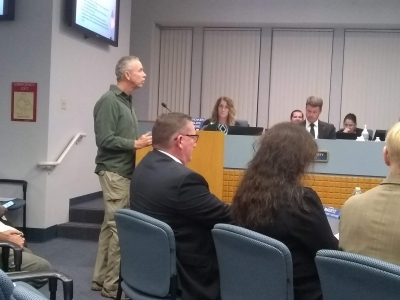 By Mike Allen
By Mike AllenJanuary 12, 2020 (Santee) -- The city of Santee is, like most small cities in the state, strapped for funds. Councilmembers are unhappy about complying with the many mandates promulgated by what they view as the big, bad guys in Sacramento.
The City Council finally got to scratch one lingering mandate off its list last week when it unanimously approved its Sustainable Santee Action Plan.
That’s the Climate Action Plan every city in California must create to show that the city is seriously trying to reduce their greenhouse gases.
It’s taken some time to get the plan created. The process started in 2014, but came to halt when funding was deemed insufficient, then was resumed in 2017. Total cost for the 432-page document: $275,000.
Mayor John Minto, speaking at the Jan. 8 meeting, made no bones about why the city was shelling out such sums. “We talked about getting a plan that doesn’t drag us off into court,” he said. “But the state will probably change the playing field and drag us into court.”
 When the city’s climate plan first came to the Council in August, it spurred a flurry of opposition from local environmental groups and others who criticized it as being worthless because the vast majority of the proposed goals and measures were voluntary. The new wording calls for mandatory audits for specific triggering events.
When the city’s climate plan first came to the Council in August, it spurred a flurry of opposition from local environmental groups and others who criticized it as being worthless because the vast majority of the proposed goals and measures were voluntary. The new wording calls for mandatory audits for specific triggering events.For example, the first goal in the plan calls for increased energy efficiency in existing residential units. If a homeowner now decides to expand or do any significant remodeling, that will result in a mandatory energy audit.
City staffers and contracted consultants said such audits could easily be accomplished by calling San Diego Gas & Electric, which offers such assessments without charge and provides free LED bulbs, as well as other low cost components to owners.
Yet Councilman Rob McNelis noted such audits could cost homeowners significant amounts, such as when an old refrigerator is deemed too high in emissions and must be replaced with a new model. He also railed at another recent mandate from the state requiring businesses to install an electric recharging station at 5 percent of their parking spaces. “If you’re a small business, where are you going to come up with the money?” he asked.
 Van Collinsworth of Preserve Wild Santee (photo, right, September 18, 2019) criticized the latest iteration of the climate plan, stating it gave the appearance of taking action without requiring sufficient action, and could do more harm than good.
Van Collinsworth of Preserve Wild Santee (photo, right, September 18, 2019) criticized the latest iteration of the climate plan, stating it gave the appearance of taking action without requiring sufficient action, and could do more harm than good.He also ripped the Council for not taking the easiest and quickest step in reducing emissions, which is joining a community choice energy program.
Santee considered and looked at joining a couple of such arrangements last year, but decided to pass. Instead, it opted to work with San Diego County, which is considering forming a CCA (community choice aggregation) in the future.
According to the Climate Action Plan’s lofty goal, Santee pledges it will reduce its greenhouse gas emissions by 40 percent below its 2005 levels by 2030.
The biggest causes of these emissions, actually 91 percent, are the ever-increasing number of vehicles in and around the city. Several members railed at the environmentalists who criticized the city’s climate plan as inadequate, stating that Santee was actively working towards improving the main arterial into the city, State Route 52.
“Who’s working to decrease that traffic? We are,” said Councilman Ronn Hall. “Let’s get the climate action people to go down to SANDAG (San Diego Association of Governments, the regional transportation planning agency) and tell them to fix the 52.”
Councilman Stephen Houlahan, a strong environmental supporter, tried to address the objections raised by several speakers and his colleagues about the plan’s shortcomings, but even he was less than enthusiastic with the final product. “This is a compromise that’s been a long time in coming,” he said. “We’ll be finally doing something.”
Houlahan responded to one speaker who said because the developers of Fanita Ranch contributed some $93,000 to offset the plan’s cost, it was tantamount to giving the developer, HomeFed Corp., a rubber stamp for its pending 3,000 unit project.
 “This won’t be a rubber stamp for Fanita Ranch,” Houlahan said.
“This won’t be a rubber stamp for Fanita Ranch,” Houlahan said.Fanita Ranch is still going through the approval process at the staff level, but needs a general plan amendment because the latest version exceeds the current general plan’s parameters. The proposed residential development could also trigger a city-wide vote if city voters approve a citizens’ initiative on non-conforming projects in November.
In other action, the City Council met in closed session but delayed any vote on a proposed development agreement between the city and Excel Acquisitions LLC regarding the sale of a parcel in Trolley Square for a new hotel. According to a staff report, the city is selling the parcel that was formerly intended as the city’s new library to accommodate a four-story hotel of 96 rooms, with a pool and about 80 parking spaces. The Council delayed voting on the agreement until Feb. 26 because negotiations between the parties have not concluded.








Recent comments